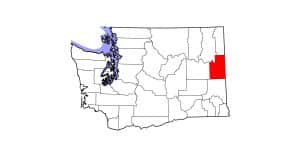Dealing With Pooling Urine and Frozen Winter Horse Paddocks
- Topics: Article, Farm and Barn, Horse Care, Safety, Seasonal Care, Welfare and Industry, Winter Care

Winter is here, and you and your horse live in a climate where managing paddocks and confinement areas presents challenges. Sure, you pick up manure each day and have footing to combat erosion and mud, but even with good daily manure removal, sometimes doing chores is extremely challenging. The paddock becomes slick and icy, and pee spots become disgusting frozen pools of urine. What can be done to make winter horse life easier?
Before we look at some helpful strategies, let’s review the basic tenants of mud management and drainage for horse paddocks.
If possible, locate your horse’s confinement area in a higher, well-drained area so water moves away and doesn’t accumulate in paddocks or buildings. Also, make sure any nearby hills or surfaces are not funneling runoff in your direction. If so, a water bar, swale, or dry well could help redirect the flow.
Your barns, shelters, and outbuildings need well-functioning rain gutters and downspouts free of debris, leaks, or breaks. These divert rainwater away from high-traffic areas, substantially reducing the amount of winter mud created in your paddocks. Watch for ice dams in gutters during winter, and break them up as they start to occur.
Footing
Your confinement area’s footing should be well-draining, especially in winter and during the rainy season. Chose something like ½-inch or 5/8-inch “washed” crushed rock. Washed rock, sometimes called “clear,” means this material is all the same size and is without fines or smaller particles. Fines cut down on pore space between pieces of gravel, thereby reducing drainage; the smaller the pore space, the poorer the drainage. Sand footing is in the poor drainage category, as it has very small pore space, so it might not be an adequate, well-draining footing for a winter paddock. Note: Any rock product 1 inch or larger is generally uncomfortable for a horse to stand on. In addition, material with a very large pore space can make picking manure difficult, and small pieces of organics left behind create a layer of mud, which clogs drainage.

Manure Removal
Remove manure daily from all confinement areas and high-traffic sites. Manure is composed of fine organic material that holds moisture and, therefore, is prone to freezing. It also creates mud. A horse produces about 50 pounds of manure a day which, if not removed, is 50 pounds of muck per day per horse.
Tips for Dealing With Frozen Paddocks and Pee Spots
Here are some options for dealing with frozen paddocks, pee spots, and ice:
- If you have a high-traffic area that isn’t draining well, consider digging it out (or at least digging out the worst spots) and replacing it with some type of clean, washed footing such as 5/8-inch washed crushed rock. In some cases “homeowners 5/8 inch gravel” might be appropriate. Homeowners does contain fines material but not nearly as much as 5/8-inch minus does, and it’s usually less expensive than a washed product. Homeowners does not compact; instead, it remains loose and drains well. Some horse owners prefer pea gravel, which drains well. Larger round drain rock is too big for horse comfort and chore efficiency. Whatever rock product you choose for footing, be sure it’s large enough with sufficient pore space for drainage but not so large that it’s uncomfortable for a horse to stand on or difficult to remove manure from.
- If you have a large confinement area that’s impractical to outfit with expensive footing across the whole surface, consider using hot tape or other fencing to create a temporary, smaller confinement area within the bigger area that you can use during winter storm events. This smaller area should have well-draining footing in place along with the other mud management techniques mentioned above. If it’s challenging to keep manure picked up in the larger area, consider blading it out (with a tractor and bucket) in the spring once things dry, then resume regular manure management for the entire space.
- Consider installing (prior to winter) a well-draining geo grid product in your highest traffic area using a clear, washed crushed rock product as fill. Ensure it functions correctly by keeping manure picked up and the area tidy.

For paddock ice buildup and slippery areas:
- When the weather gods bring you snow, consider shoveling or removing it from paddocks to prevent snow and ice buildup. You can do this by hand with a shovel or by tractor.
- Keep a pile of sand accessible for the winter months. If possible, tarp or cover the pile to prevent extra moisture from seeping into it and freezing in cold weather. Alternately, you might have an area of a sand arena you can “borrow” sand from. Use a tractor with a bucket to convey sand to areas where needed and a metal garden rake to scatter it over icy spots to provide traction. Keep in mind that using sand can plug pore space and further reduce drainage.
- Break/chop ice with a flat edged shovel or an ice-chopping tool (sold in hardware or landscape stores). This approach requires quite a bit of hard work and muscle power but is probably the best way to get ice out of horse areas.
- Try sprinkling rock salt (sodium chloride) on icy patches. Salt will damage any nearby plants by dehydrating plant tissues, and in high levels it’s toxic to animals. It can also dry out dogs’ paws and potentially horse hooves or coats if they roll in too much of it. Plus, salt is corrosive to concrete, metals, and wood and only works down to 20 degrees Fahrenheit. However, it’s inexpensive and might aid in getting rid of a dangerous ice situation—as long as temps aren’t too extreme. Keep in mind that this method it meant to aid in snow/ice removal and is not a recommended method to handle an entire snow removal job.

Create Confinement Areas
We use paddocks to confine our horses for two main reasons.
The first is for pasture health to prevent overgrazing and soil compaction. At a minimum, your horses should be confined to a paddock during the winter and early spring to prevent potential damage to your pasture. At least 3 inches of leafy grass is needed for rapid regrowth in the spring. Compaction of wet pasture soils makes water infiltration and root growth difficult. Poor pasture management results in reduced grass quality and quantity, increased soil erosion, nitrogen runoff (from manure and urine), and weeds. Lower pasture productivity also increases feed costs and potentially vet bills if your horse eats toxic weeds.
Second, use of a confinement area helps manage a horse’s weight and health. Many horses develop overweight issues from being on pasture, and even brown winter pastures can be high in nonstructural carbohydrates.
Take-Home Message
Managing a poorly draining, icy confinement area is tough and, unfortunately, there is no one-size-fits-all solution. Experimenting with these strategies might help you come up with a balance that works for your situation.

Written by:
Alayne Blickle
Related Articles
Stay on top of the most recent Horse Health news with












